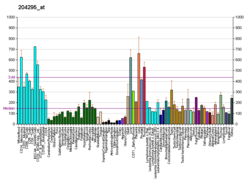Clinical significance
Mutations in SURF1 have been associated with mitochondrial complex IV (cytochrome c oxidase) deficiency with clinical manifestations of Leigh syndrome and Charcot-Marie-Tooth disease 4K (CMT4K). [7] [8] [14]
Leigh syndrome
Leigh syndrome is an early-onset progressive neurodegenerative disorder characterized by the presence of focal, bilateral lesions in one or more areas of the central nervous system including the brainstem, thalamus, basal ganglia, cerebellum and spinal cord. Clinical features depend on which areas of the central nervous system are involved and include subacute onset of psychomotor retardation, hypotonia, ataxia, weakness, vision loss, eye movement abnormalities, seizures, and dysphagia. There have been over 30 different mutations in SURF1 that have been associated with Leigh syndrome. These mutations, which comprise at least 10 missense or nonsense, 8 splice site, and 12 insertion or deletion mutations, are believed to be the result of dysfunctional SURF1 that results in Leigh syndrome and cytochrome c oxidase deficiency. The most common mutation is believed to be 312_321del 311_312insAT. [14] [7] [8]
Charcot-Marie-Tooth disease 4K (CMT4K)
Charcot-Marie-Tooth disease 4K (CMT4K) is an autosomal recessive, demyelinating form of Charcot-Marie-Tooth disease, a disorder of the peripheral nervous system, characterized by progressive weakness and atrophy, initially of the peroneal muscles and later of the distal muscles of the arms. Charcot-Marie-Tooth disease is classified in two main groups on the basis of electrophysiologic properties and histopathology: primary peripheral demyelinating neuropathies (designated CMT1 when they are dominantly inherited) and primary peripheral axonal neuropathies (CMT2). Demyelinating neuropathies are characterized by severely reduced nerve conduction velocities (less than 38 m/sec), segmental demyelination and remyelination with onion bulb formations on nerve biopsy, slowly progressive distal muscle atrophy and weakness, absent deep tendon reflexes, and hollow feet. By convention, autosomal recessive forms of demyelinating Charcot-Marie-Tooth disease are designated CMT4. CMT4K patients manifest upper and lower limbs involvement. Some affected individuals have nystagmus, polyneuropathy, putaminal and periaqueductal lesions, and late-onset cerebellar ataxia. This disease, when associated with mutations in SURF1, has been found to be linked to cytochrome c oxidase deficiency. Variants associated with this CMT4K have included a homozygous splice site mutation, c.107-2A>G, a missense mutation, c.574C>T, and a deletion, c.799_800del. [10] [7] [8]
This page is based on this
Wikipedia article Text is available under the
CC BY-SA 4.0 license; additional terms may apply.
Images, videos and audio are available under their respective licenses.




